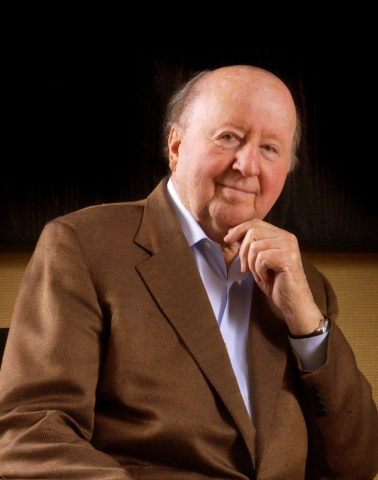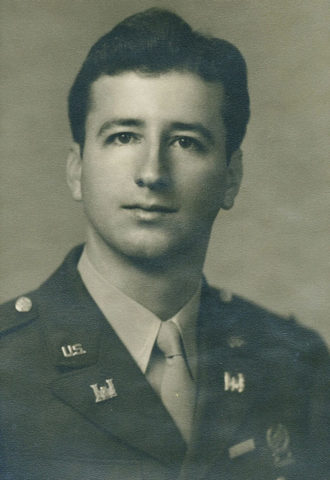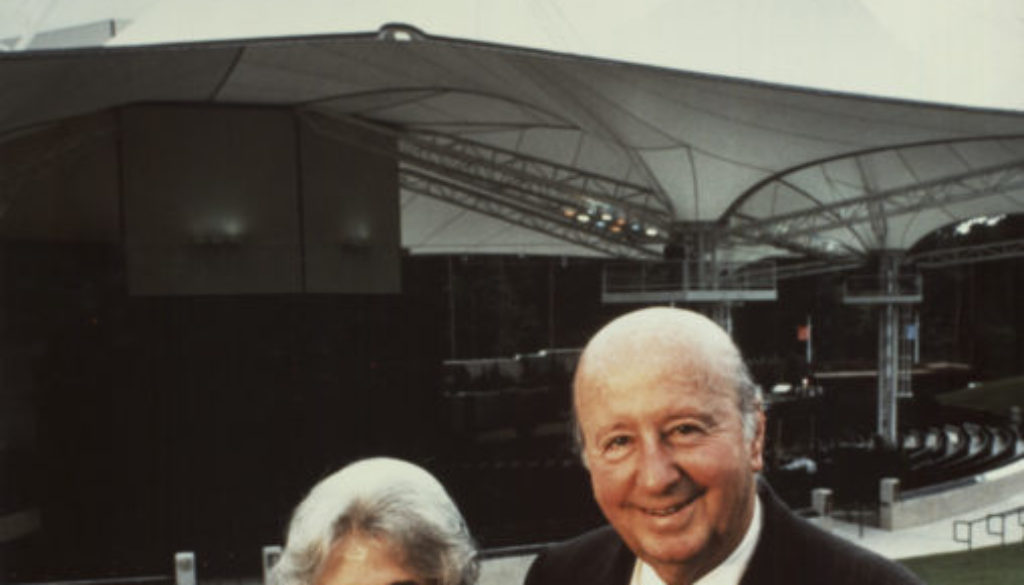Texas A&M Mourns Legendary Houston Philanthropist and Distinguished Former Student George P. Mitchell
Houston businessman George P. Mitchell, a 1940 distinguished petroleum engineering graduate of Texas A&M University, legendary oil and gas pioneer and real estate developer, and all-time most generous donor in Texas A&M history, has passed away at the age of 94.
Memorial service arrangements are pending for Mitchell, who died Friday (July 26) at his home in Galveston, according to family. A World War II veteran who served with the Army Corps of Engineers, he was preceded in death by his wife, Cynthia Woods Mitchell, in 2009 and is survived by 10 children, 23 grandchildren and several great-grandchildren. A statement from the Mitchell family is viewable online at http://cgmf.org/p/family-statement.html.
“George Mitchell was a great example of what makes this university so special,” said Texas A&M University System Chancellor John Sharp. “He truly loved the school and believed in paying forward to benefit the next generation of great Aggies with his time, talent and treasure. The George P. and Cynthia Woods Mitchell Institute for Fundamental Physics and Astronomy will be a visible legacy, but his impact and influence runs deep throughout Aggieland, as Texas A&M’s largest benefactor ever, and the world. The fracking technology he made available to the world will pay huge dividends, not just to Texas, but the world. We will never forget him and his family.”


Mitchell, the son of a poor Greek immigrant who made his fortune finding oil and gas where others couldn’t, earned his five-year degree in petroleum engineering with an emphasis in geology from Texas A&M in only four years, graduating as the valedictorian of his class and captaining the men’s tennis team. His visionary support for his alma mater includes the 135 acres for Texas A&M University at Galveston’s main campus and more than $88 million to Texas A&M Physics and Astronomy — most recently a $20 million legacy gift in 2012 to benefit his namesake George P. and Cynthia Woods Mitchell Institute for Fundamental Physics and Astronomy that brought his total commitments to Texas A&M University to more than $95 million, solidifying his position as the university’s all-time most generous donor.
“All of us in the Texas A&M family are deeply saddened by the death of George Mitchell — a great man and a great Aggie,” said Texas A&M University President R. Bowen Loftin. “Without question, he was a true visionary in every sense of the word. He didn’t see limits, only possibilities — possibilities that he converted into realities to fulfill his vision. His achievements have benefited all mankind and certainly those of us in Texas and at Texas A&M.
“On a personal note, George was a close friend and mentor for almost a decade. While I will miss his wisdom, candor, friendship and great sense of humor, his memory will forever be etched in the hearts of those of us who knew him well and had great admiration for him. His legacy will live on through the countless Texas A&M students — past, present and future — as well as the many faculty and staff whose lives have been impacted in a positive way by his extraordinary generosity and selfless service to the university he loved. He will most definitely be missed.”
Bhaskar Dutta, Texas A&M physics professor and interim director of the Mitchell Institute, echoed those sentiments in the following statement posted on the institute’s website:
“The Mitchell Institute for Fundamental Physics and Astronomy remembers and honors its sole visionary patron and pioneering benefactor, Mr. George Mitchell, who has passed away the morning of July 26, 2013. With his death, the world has lost a true champion of philanthropy and a great advocate for the cause of physics and astronomy. Our deepest condolences go to all the members of the Mitchell family in this time of shared grief.”
Mitchell is former chairman and chief executive officer of Mitchell Energy & Development Corp., one of the largest independent gas and oil producers in the nation before merging with Devon Energy Corporation in 2002. As the undisputed father of the Barnett Shale natural gas field, Mitchell pioneered the technique of horizontal drilling with a light sand frac. It took him 17 years of experimentation to demonstrate that this approach to extracting gas from shale formations was economically viable. His unconventional thinking and unwavering determination, coupled with the exploitation of this technology, opened up huge natural gas reserves that have revolutionized the United States’ energy future.
“George Mitchell was always a visionary,” said Ed Davis, president of the Texas A&M Foundation and Texas A&M Class of 1967. “Fascinated with astronomy as a young man, his vision allowed him to pursue a career that favorably looked into the ground: petroleum engineering. His resolute pursuit of hydraulic fracturing helped him achieve his dream and to potentially return the U.S. to energy independence. He reinvested his success in helping Texas A&M build the finest astronomy and physics program in the world. His generosity will allow many others to be visionary as well, and literally see the stars. George Mitchell was one of Texas A&M’s greatest icons, and he will be missed, but his legacy will continue to inspire Aggies.”
Throughout a successful career in the petroleum industry, Mitchell retained a lifelong interest in physics and astronomy, an interest he and Cynthia shared. In 2002, they committed their first million-dollar gift to Texas A&M to establish the Mitchell Institute, which was named in Mitchell’s honor at the suggestion of world-renowned Cambridge University theoretical physicist Stephen Hawking, one of his lifelong heroes and eventual friends. In 2005, the Mitchells pledged $35 million toward the construction of Texas A&M’s $82.5 million physics buildings, designed at their behest by noted architect Michael Graves and named in their honor as respective homes to the Mitchell Institute and the Department of Physics and Astronomy. The couple also has provided funding toward 10 academic chairs and professorships, a post-doctoral fellowship in astronomy, and a related lecture series.
“The College of Science, and indeed Texas A&M, has benefited greatly from the fact that Mr. Mitchell had a passion for physics and astronomy — and science in general,” said H. Joseph Newton, dean of the College of Science and inaugural holder the George P. Mitchell ’40 Chair in Statistics. “I know I will miss him personally, and I will miss hearing about how much he loved Texas A&M.”
Mitchell, who once built his own telescope as a high school student, also has committed $33.25 million thus far to the Giant Magellan Telescope. His generous support for the next-generation, ground-based wonder is bookended by his lead gift of $1.25 million in 2004 to establish Texas A&M as a founding partner and, most recently in 2011, a $25 million gift involving another of his visionary legacies, the Cynthia and George Mitchell Foundation, credited equally to Texas A&M and the Carnegie Institution for Science.
For decades, the Mitchells have been major benefactors of Texas A&M’s marine-oriented branch campus in Galveston, donating among other gifts the land for its main campus that carries Mitchell’s father’s name. They also provided major funding for Texas A&M’s statistics and petroleum engineering departments and the George P. Mitchell ’40 Outdoor Tennis Center.
“It is hard to express in words what George Mitchell meant to Texas A&M University at Galveston, its students, faculty and staff, and to me personally,” said Rear Admiral Robert Smith III ’61, president/chief executive officer at Texas A&M at Galveston. “To say he was a great man with foresight and generosity isn’t enough. His contributions to this university literally made this institution possible. The very land it sits on was donated by Mr. Mitchell in honor of his father, and his support never waned. But more than that, it was his friendship that we shall always cherish. He will be deeply missed, but his spirit shall go on forever within this university.”
In addition to his oil and gas successes, Mitchell became one of the most successful real estate developers in the Houston-Galveston region, founding The Woodlands, a master-planned new town north of downtown Houston. He and Cynthia also played a key role in the rejuvenation of Galveston’s historic Strand District and the rebirth of its Mardi Gras celebration.
Mitchell also founded the Houston Advanced Research Center (HARC), a contract and grant research institute headquartered in The Woodlands’ Research Forest and dedicated to his longstanding belief that if Texas’ great universities would work together, they could compete on any level. One of HARC’s first deliverables was the design of a shielded magnet to accelerate sub-atomic particles for the Superconducting Super Collider (SSC), which eventually fell victim to federal funding cuts in 1993 and went down in history as one of Mitchell’s biggest disappointments — common ground that he shared with Hawking.
Cards, letters and other written forms of condolences also may be addressed to the George P. Mitchell Family in care of The Mitchell Family Corporation, 24 Waterway Avenue, Suite 300, The Woodlands, Texas 77380.
For additional information, please visit the Cynthia and George Mitchell Foundation website at www.cgmf.org.
See a 2006 DISCOVERY magazine feature on Mitchell and his early involvement with Texas A&M Physics and Astronomy.
Read a February 2012 feature story on Mitchell and his contributions to the energy industry as the first installment in Texas A&M’s past 12 Impacts of the 12th Man series.
See a list of quotes, tributes and news clips memorializing Mitchell.
-aTm-
Contact: Shana Hutchins, (979) 862-1237 or shutchins@science.tamu.edu
The post Texas A&M Mourns Legendary Houston Philanthropist and Distinguished Former Student George P. Mitchell appeared first on Texas A&M College of Science.
